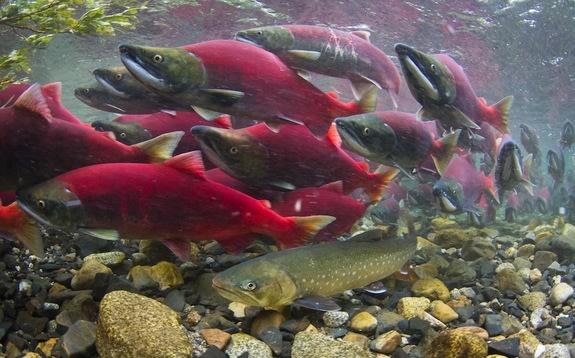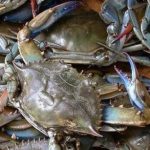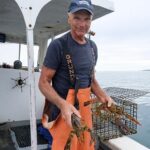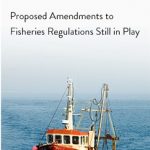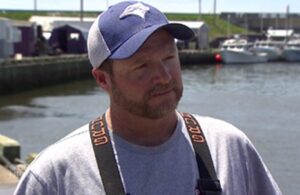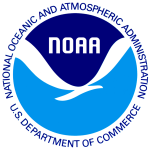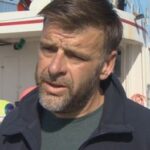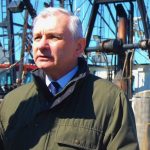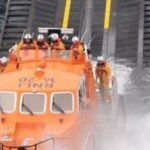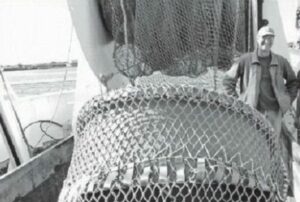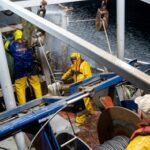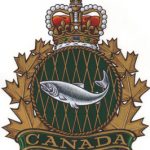Tag Archives: sockeye
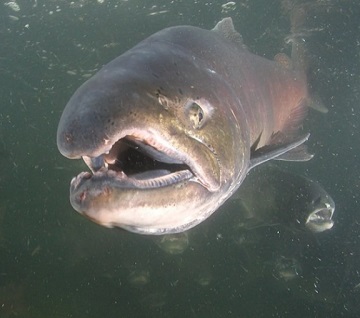
What salmon eat in the open ocean
After one to two years of munching on zooplankton in freshwater, young sockeye – or smolt – head for salt water to begin the next chapter of their anadromous lives, where there’s a whole different menu available. Dr. Katie Howard studies salmon diets in the open ocean and is an ocean fisheries scientist with the Alaska Department of Fish and Game. “The sockeye, pink and chum, eat a pretty diverse array of invertebrates and fish,” she said. “And the amount that their diets overlap or don’t overlap, is really dependent on where they are.” Howard calls these three species of salmon generalists; for the most part, they’ll eat whatever is available to them. But she says chinook, or king salmon, choose different marine meals. “Chinook tend to focus more on fish and squid. But, which fish and which squid really depends on where they are and what’s available,” she said. >click to read< 11:08
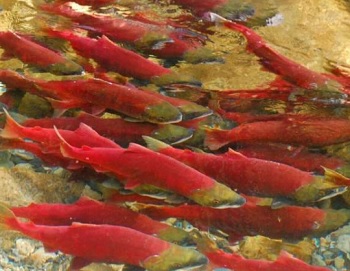
Female Sockeye salmon are dying at higher rates than males
Female adult sockeye from the Fraser River are dying at significantly higher rates than their male counterparts on the journey back to their spawning grounds, “This is causing skewed sex ratios in their spawning grounds, something that has been observed in recent years,” says lead researcher Dr. Scott Hinch, a professor in the faculty of forestry and head of the Pacific Salmon Ecology and Conservation Laboratory at UBC. “The implications on the health of Fraser River stocks are concerning, particularly as Pacific salmon populations in British Columbia have been declining over the past several decades.” >click to read< 15:48
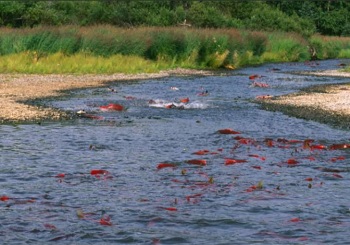
Alaska’s wild salmon are getting smaller
For years, people in Alaska have been noticing that wild salmon were getting smaller, but the reasons have been unclear. In the new study, published August 19 in Nature Communications, researchers compiled and analyzed data collected over six decades (1957 to 2018) from 12.5 million fish by the Alaska Department of Fish and Game. This unprecedented dataset enabled them to see patterns of body size changes for four species of salmon, Chinook, chum, coho, and sockeye, across all regions of Alaska. The results showed that the decreases in body size are primarily due to salmon returning to their spawning grounds at younger ages than they have in the past. >click to read< 11:24
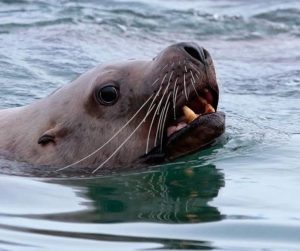
Seal hunt proponents hope new evidence sways skeptical fisheries officials
Three new studies being prepared for publication suggest that recovered populations of seals and sea lions in west coast waters could be having an outsized impact on the survival of the three most troubled Pacific salmon species — chinook, coho and sockeye. “Most of the drop in survival of chinook and coho in the Georgia Strait since the 1980s is likely due to seals eating juvenile fish during their first summer in the ocean,” said Carl Walters, a professor emeritus at UBC’s Institute for the Oceans and Fisheries. Estimates suggest that seals may be consuming about five million juvenile coho each year, or about half of the juveniles that enter the area from streams and rivers. Up to 15 million chinook juveniles meet the same fate, about one third of that population. >click to read< 09:21
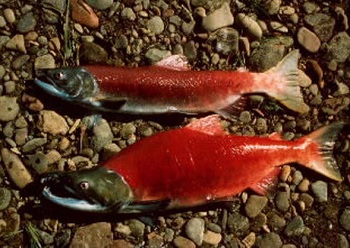
Historic Alaska heatwave is killing off thousands of salmon
Unusually warm temperatures across Alaska this summer has led to die-offs of unspawned chum, sockeye and pink salmon, with the warm waters acting as a “thermal block,” basically a wall of heat salmon don’t swim past, delaying upriver migration.,,, “Cook Inletkeeper has been tracking stream temperatures in non-glacial systems across the Cook Inlet watershed since 2002. But this is a first – we’ve never seen stream temperatures above 76 degrees Fahrenheit,” wrote Mauger. “Physiologically, the fish can’t get oxygen moving through their bellies,”,,, >click to read< 09:46
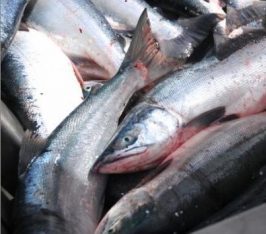
Kenai River sockeye push liberalizes bag limits; commercial catches rise
After a slow start to their season, things are looking up for Upper Cook Inlet’s commercial fishermen. Total salmon landings reached 1.4 million after the July 29 fishing period, with more than 1.1 million sockeye so far. The majority of those landings have come from the Central District drift gillnet fleet and east side setnets, with setnetters on the west side, Kalgin Island and in the Northern district bringing in about 150,000 salmon between them, according to the Alaska Department of Fish and Game. Elizabeth Earl >click to read< 15:29
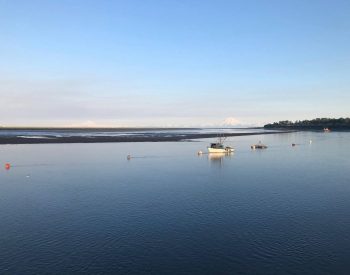
Cook Inlet fishermen celebrate ‘Return of the Reds’ with hope for 2019
Cook Inlet fishermen are looking forward to their salmon season with high hopes that the sockeye will arrive in better numbers than last year. On June 11, fishermen and processors grilled up some of the first Cook Inlet salmon of the year at the Pacific Star processing plant in Kenai, gathering to build excitement for the coming season. The plant is now receiving salmon from the west side of Cook Inlet, while the fishermen in the drift gillnet and east side set gillnet fleets gear up for their first expected openings in the coming weeks. >click to read<15:24
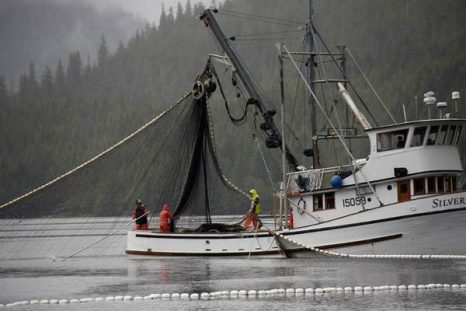
Durango anglers set to head to Alaska for salmon run
The Copper River season takes off mid-May with the king salmon run.,,, A month later, further southeast, Eric Macias and his crew will board the 58-foot Silver Wave, named after a shoal of shimmering coho. It also shares its name with the fish company that sells salmon in filets and cans in Southwest Colorado that Macias and his partner, MJ Carroll, run. “We come in at the end of the king run,” Macias said. “I’m a seiner, so I have a bigger boat, a bigger crew, and I catch a bigger volume of fish at one time.”>click to read<15:30
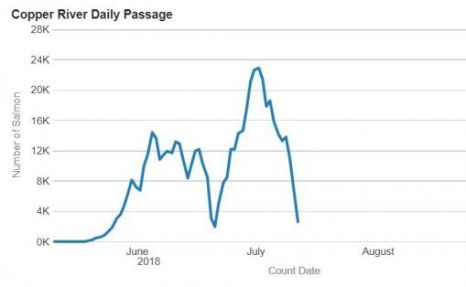
Copper disaster
No sooner did the burst of sockeye salmon into the Copper River begin than it was over. With the famous salmon river in eastern Alaska again falling behind projected daily returns, the Alaska Department of Fish and Game announced today that a Thursday through Sunday opening of the popular personal-use dipnet fishery will likely be the year’s last. The weak sockeye run has now turned into a disaster for almost everyone. Cordova commercial fishermen off the mouth of the river caught only 26,000 of the highly valuable sockeye in three short openings in May before they were shutdown for the year. >click to read<20:33
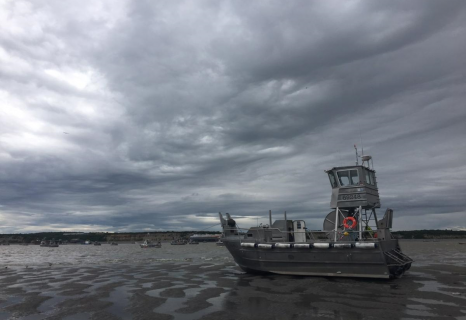
Naknek-Kvichak District closes to boost Kvichak River Escapement, Special Harvest Area will be open
A big announcement today from the Alaska Department of Fish and Game today. The Naknek-Kvichak District is closed. The Naknek River Special Harvest Area will be open to drift gillnet gear tonight at 8 p.m. That triggers the Egegik District to close and move into the Egegik River Special Harest Area. Drift gillnetters there will also see an 8 p.m. opening. Across Bristol Bay’s five districts, no dual permit boat may have more than 150 fathoms of gear on board, starting this at 8 p.m. as well. These restrictions are an effort to boost escapement on the Kvichak River, which is far behind where it needs to be to meet the bottom end of its goal, 2 million sockeye. >click to read<20:09
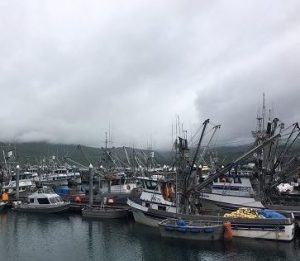
Chignik fishermen stuck ashore as sockeye run fails
Communities around the Gulf of Alaska are struggling with low sockeye returns, and villages near the Chignik River are no different. The region is experiencing its weakest recorded run in the last in 50 years. Fishermen are stuck waiting for a commercial opener,,, There’s really only one thing to talk about in Chignik Bay these days — where are the sockeye? “Shock is pretty much the guaranteed feeling of most people as kinda everybody walking around dazed.” according to Ben Allen, a local fisherman. It’s to the point where residents have pulled their subsistence nets voluntarily to try and get every salmon they can up the Chignik River.,, And, like other nearby communities, red salmon is the main source of income that keeps the lights on in the village. >click to read<18:12
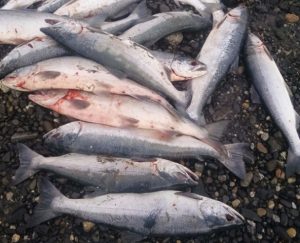
Deadly success?
Twenty-eight years ago, the state of Alaska banned fish farming in favor of salmon ranching. The idea was simple: Catch a bunch of fish, squeeze out their eggs and sperm, mix the two together, hatch the eggs, raise the little fish in a hatchery, dump them in the ocean, wait for them to come back, and net the money. What could possibly go wrong? Maybe this: From 1985 to 1994, before the hatchery program seriously geared up in the Prince William Sound, the commercial catch of sockeye (red) salmon in Cook Inlet averaged about 5.3 million fish per year.>click to read<10:34
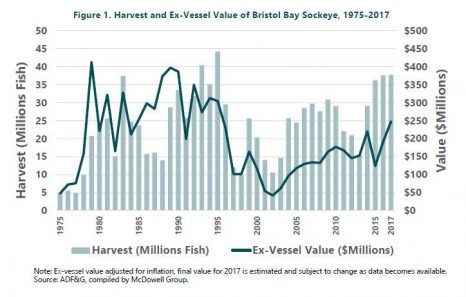
Positive trends highlighted in fall sockeye market analysis
Bristol Bay’s commercial fishing industry had a smashing good season in 2017. The massive forecast for next year has stirred a lot of excitement, and drift permit prices are up around $140,000. Now an annual analysis of the sockeye market suggests wholesale and retail prices are up, worldwide supply is down, and farmed salmon producers are still struggling to rebound. Only the prospect of Pebble Mine filing for permits has seemed to dampen the mood of Bristol Bay fishermen this fall. Andy Wink, a senior seafood industry analyst at the McDowell Group, authored the “2017 Sockeye Market Analysis” for the Bristol Bay Regional Seafood Development Association. click here to read the story 08:18
Alaska salmon season a success in global market
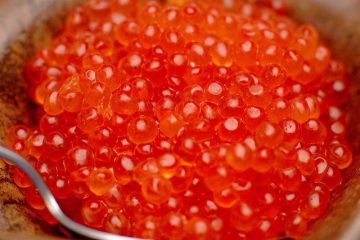 It was a generally good salmon season for Alaska, except for one species. “It was a disastrous year for chinook harvest.” That’s Andy Wink, a seafood economist with the consulting firm McDowell Group. Wink says while king salmon may be the most famous salmon species among Alaskans, it also makes up the lowest total value of all the different commercial salmon species. “Sockeye, pink salmon, chum salmon, those are the species that for the commercial fleet really move the needle in terms of total value.” click here to read the story 19:25
It was a generally good salmon season for Alaska, except for one species. “It was a disastrous year for chinook harvest.” That’s Andy Wink, a seafood economist with the consulting firm McDowell Group. Wink says while king salmon may be the most famous salmon species among Alaskans, it also makes up the lowest total value of all the different commercial salmon species. “Sockeye, pink salmon, chum salmon, those are the species that for the commercial fleet really move the needle in terms of total value.” click here to read the story 19:25
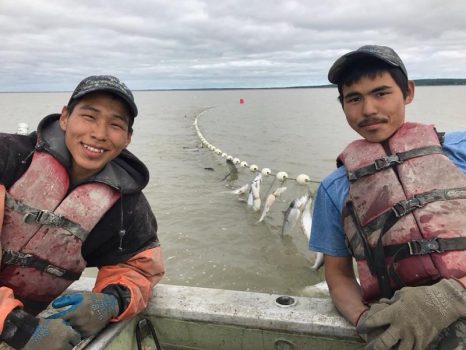
A big harvest + a buck a pound: Bristol Bay 2017 will be one for the books
Mother Nature sent way more sockeye back to Bristol Bay than was expected, and many fishermen recorded their top seasons ever. As other fisheries fall short, the market is eager for all the fish the Bay can provide, so the fleet goes home with a better price, too. The ex-vessel value may be the highest since early 90s.The Bristol Bay run is not over yet, with word Monday that the Kvichak River seemed to finally “pop”, but this year’s fishery is shaping up to be one of the largest ever and certainly one of the most valuable in a long time.,,, “We are really happy to see several processors posting $1/lb base price – especially considering the base price just 2 years ago was .50 cents,” said Bristol Bay Regional Seafood Development Association executive director Becky Martello. “With much of the fleet now chilling and bleeding, it means that our fishermen can get upwards of $1.25/pound. That’s good news for the fleet and the fishery.” click here to read the story 17:51
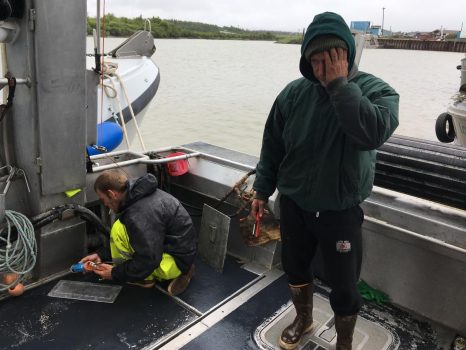
The Nushagak run surges early, and maybe big too?
Bristol Bay’s westside district posts a million sockeye catch Monday, and both the Wood and Nushagak Rivers have met their escapement goals. The red run is off the charts, but the kings are lagging big time.,,, On Sunday June 25, the fleet caught more than 400,000 sockeye, and Monday’s tally was an incredible 1,050,000. “Since I’ve been here, the single day harvest has never exceed a million fish,” Sands said Tuesday morning after the counts came in. “I talked to Jeff Skrade [his predecessor], and he recalls once in 1981 breaking the million fish harvest, and I don’t know if that was sockeye or just fish, but, we’re pretty excited down here to see such a big harvest.” click here for audio, read the story 11:09
A total shutdown of all salmon fisheries on the Fraser River to conserve sockeye
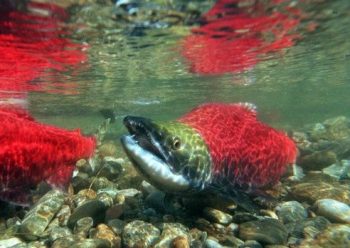 The Fraser River was shut down Thursday at sundown to all salmon fishing due to conservation concerns about sockeye. The notice of “immediate closure” of all salmon fisheries went out from DFO for the tidal and non-tidal sections of the Fraser. “Current run size estimates of Fraser River Summer Run sockeye salmon have resulted in no allowable harvest and a conservation concern,” according to the abrupt notice from Fisheries and Oceans Canada. The Summer run of Fraser sockeye is usually the strongest. Not this year. “The Department’s first priority is to ensure that there is sufficient sockeye returning to the spawning grounds. The Department will manage all fisheries to minimize sockeye impacts and provide priority access to First Nations’ fishing for food, social and ceremonial purposes.” Recreational anglers had been targeting chinook selectively but the risk was considered is too great for accidentally intercepting sockeye. DFO even mentioned it in their notice. Read the rest here 14:23
The Fraser River was shut down Thursday at sundown to all salmon fishing due to conservation concerns about sockeye. The notice of “immediate closure” of all salmon fisheries went out from DFO for the tidal and non-tidal sections of the Fraser. “Current run size estimates of Fraser River Summer Run sockeye salmon have resulted in no allowable harvest and a conservation concern,” according to the abrupt notice from Fisheries and Oceans Canada. The Summer run of Fraser sockeye is usually the strongest. Not this year. “The Department’s first priority is to ensure that there is sufficient sockeye returning to the spawning grounds. The Department will manage all fisheries to minimize sockeye impacts and provide priority access to First Nations’ fishing for food, social and ceremonial purposes.” Recreational anglers had been targeting chinook selectively but the risk was considered is too great for accidentally intercepting sockeye. DFO even mentioned it in their notice. Read the rest here 14:23
Fisheries Minister plans ‘concrete’ action to fight declining Fraser River sockeye run
 Canada’s Minister of Fisheries says the government is taking action in a ‘rigorous and robust’ way to restore the Fraser River’s sockeye salmon run, and it’s a top priority of the prime minister. Dominic LeBlanc says the federal government is committed to recommendations that came out of the Cohen Commission of Inquiry four years ago, agreeing delayed action has been “unacceptable.” He did not see an immediate need to sever the ministry mandate, to end the promotion of salmon farming, as Cohen recommended. “I wouldn’t describe it as a conflict of interest,” said LeBlanc. I think there is a way for world-class, transparent, open and available science and management decisions that are transparent to Canadians to be made with respect to aquaculture sector … that are complimentary to the protection of the wild salmon.” With the right science and regulatory regime, he said Canadians have confidence in the safety of B.C.’s beloved wild salmon Read the rest here 14:50
Canada’s Minister of Fisheries says the government is taking action in a ‘rigorous and robust’ way to restore the Fraser River’s sockeye salmon run, and it’s a top priority of the prime minister. Dominic LeBlanc says the federal government is committed to recommendations that came out of the Cohen Commission of Inquiry four years ago, agreeing delayed action has been “unacceptable.” He did not see an immediate need to sever the ministry mandate, to end the promotion of salmon farming, as Cohen recommended. “I wouldn’t describe it as a conflict of interest,” said LeBlanc. I think there is a way for world-class, transparent, open and available science and management decisions that are transparent to Canadians to be made with respect to aquaculture sector … that are complimentary to the protection of the wild salmon.” With the right science and regulatory regime, he said Canadians have confidence in the safety of B.C.’s beloved wild salmon Read the rest here 14:50
Bristol Bay fishermen aghast at 50-cents-a-pound price for sockeye
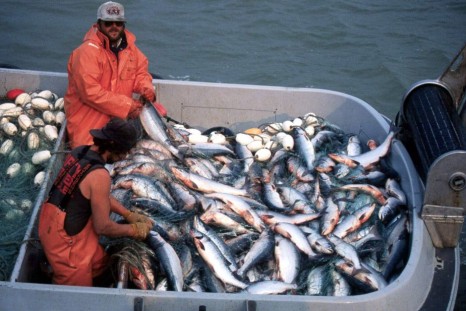 Most Bristol Bay fishermen were shocked and dismayed when they heard last week that major buyers would pay 50 cents a pound for . That’s a throwback to the dock prices paid from 2002 to 2004, and is far below the $1.20 or more paid last year. A late surge of reds produced catches of nearly 13 million fish in the final week of this year’s run, bringing the total by July 23 to 34.5 million fish. Fish were still trickling in, and state managers, who called the season an anomaly, said the final tally should reach the projected harvest of 37.6 million sockeye. Read the rest here 15:35
Most Bristol Bay fishermen were shocked and dismayed when they heard last week that major buyers would pay 50 cents a pound for . That’s a throwback to the dock prices paid from 2002 to 2004, and is far below the $1.20 or more paid last year. A late surge of reds produced catches of nearly 13 million fish in the final week of this year’s run, bringing the total by July 23 to 34.5 million fish. Fish were still trickling in, and state managers, who called the season an anomaly, said the final tally should reach the projected harvest of 37.6 million sockeye. Read the rest here 15:35
Wait period to fish Naknek-Kvichak, Egegik districts waived, strong catches continue in much of Bristol Bay.
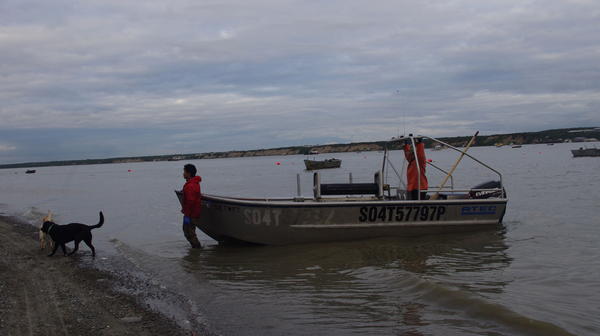 The48-hour waiting period to transfer into the Naknek-Kvichak, Egegik, Ugashik and Nushagak Districts ends by regulation July 17, but it’s waived as of Tuesday for the Naknek-Kvichak and Egegik District. Fishermen can’t transfer into the Togiak District after fishing any other district until July 27. Catches declined slightly on Monday, but are still among the highest of the season with 1.8 million fish caught that day, bringing the baywide catch to about 22.8 million, with the total sockeye run estimated at 33.7 million fish. From aboard the F/V Crimson Hunter,,, Read the rest here 19:10
The48-hour waiting period to transfer into the Naknek-Kvichak, Egegik, Ugashik and Nushagak Districts ends by regulation July 17, but it’s waived as of Tuesday for the Naknek-Kvichak and Egegik District. Fishermen can’t transfer into the Togiak District after fishing any other district until July 27. Catches declined slightly on Monday, but are still among the highest of the season with 1.8 million fish caught that day, bringing the baywide catch to about 22.8 million, with the total sockeye run estimated at 33.7 million fish. From aboard the F/V Crimson Hunter,,, Read the rest here 19:10
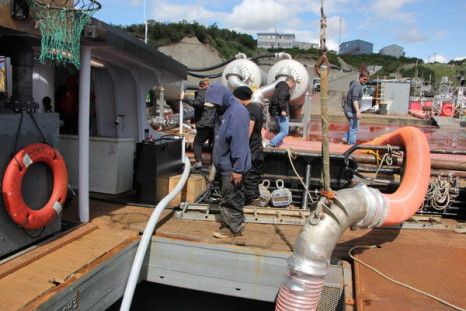
Bristol Bay run nears 20 million sockeye
Yesterday fishermen in Bristol Bay hauled in their biggest catch to date – landing about 1.7 million sockeye, including 1 million harvested out of the Naknek-Kvichak district. The total run to Bristol Bay now stands at about 20 million sockeye, which is still well below the forecast … but Port Moller’s test fishery says catches the last two days are near the highest of the season. Listen, Read the rest here 17:26
Bristol Bay fishermen hit the 2 million mark June 29 ,sockeye catch still climbing!
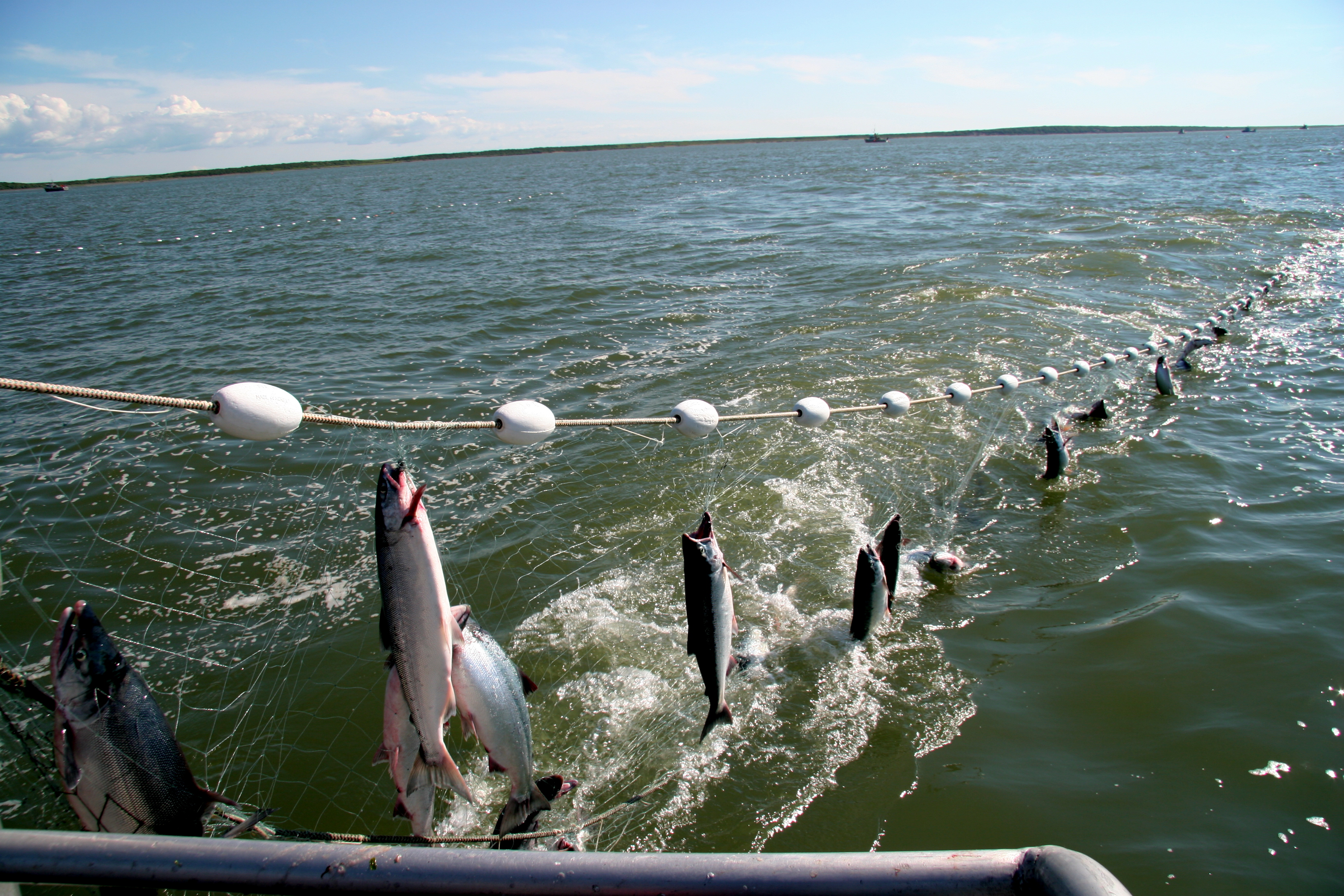 Bristol Bay fishermen hit the 2 million mark June 29. Baywide, the total catch was about 2.6 million sockeye as of June 29. If the projections are correct, that means there’s about 35 million sockeye still to be caught, and researchers have said they still expect the pre-season forecast to come to fruition. The Egegik harvest through June 29 was about 1.1 million reds, and the Nushagak catch was about 914,000. But fishermen in those districts said that fishing still felt slow. Read the rest here 09:17
Bristol Bay fishermen hit the 2 million mark June 29. Baywide, the total catch was about 2.6 million sockeye as of June 29. If the projections are correct, that means there’s about 35 million sockeye still to be caught, and researchers have said they still expect the pre-season forecast to come to fruition. The Egegik harvest through June 29 was about 1.1 million reds, and the Nushagak catch was about 914,000. But fishermen in those districts said that fishing still felt slow. Read the rest here 09:17
Sockeye overfishing risks salmon future: critics
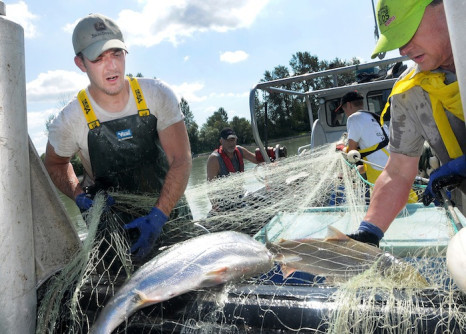 Conservationists say federal fishery managers allowed serious overfishing of Fraser River sockeye salmon,,, Bob McKamey, vice-president of the Area E Gillnetters Association, dismissed the objections from Watershed Watch. “It wouldn’t matter what the fishing plan is, they have a kneejerk reaction to the commercial fishing industry in general,” he said. Read the rest here 21:12
Conservationists say federal fishery managers allowed serious overfishing of Fraser River sockeye salmon,,, Bob McKamey, vice-president of the Area E Gillnetters Association, dismissed the objections from Watershed Watch. “It wouldn’t matter what the fishing plan is, they have a kneejerk reaction to the commercial fishing industry in general,” he said. Read the rest here 21:12
This is Fish Radio. I’m Laine Welch – Bristol Bay reds already 10 million over forecast, other AK fisheries updates
 Bristol Bay continues to have one million or more red salmon days and the catch total continues to climb. The sockeye take was at 27 million, already 10 million over the forecast, and all signs point to more fish on the way. Read more here 17:38
Bristol Bay continues to have one million or more red salmon days and the catch total continues to climb. The sockeye take was at 27 million, already 10 million over the forecast, and all signs point to more fish on the way. Read more here 17:38
Sockeye run at halfway point double 10-year average, over 20,000 a day crossing Bonneville Dam
With summer Chinook adult spawner counts on track to achieve preseason return estimates, and sockeye salmon numbers looking even better than advertised, Oregon and Washington fisheries officials this week gave their go-ahead for two more weeks of commercial fishing for treaty tribes on the Columbia River mainstem reservoirs above Bonneville Dam. Read more here 08:32
DFO POACHER PATROL Is Serious About Poaching!! Have seized eight boats and 50 gillnets as part of a crackdown on the lower Fraser
![]() Fishery officer Nicole Gallant 30 officers are currently working on the lower Fraser, and they’re using boats, vehicles and even air surveillance. Enforcement operations are taking place throughout the day and evening, and Gallant says they’ll continue until the river opens or the sockeye stop running. more@castanet 06:49
Fishery officer Nicole Gallant 30 officers are currently working on the lower Fraser, and they’re using boats, vehicles and even air surveillance. Enforcement operations are taking place throughout the day and evening, and Gallant says they’ll continue until the river opens or the sockeye stop running. more@castanet 06:49
Lake Babine sockeye fishery at risk of unprecedented closure
![]()
Aboriginal people in British Columbia who rely on Skeena River sockeye are facing some extremely difficult decisions as sockeye salmon returns plunge to historic lows. Lake Babine Chief Wilf Adam was on his way to Smithers, B.C., on Monday for a discussion about whether to entirely shut down the food fishery on Lake Babine, something he said would be drastic and unprecedented – but may ultimately be necessary. more@globeandmail
Poor outlook for B.C. sockeye salmon returns helping drive up prices – read more here
Sparse Fraser River sockeye run is an echo of 2009
 Four years after a salmon run so disastrous it sparked a federal inquiry, fisheries managers are watching with concern as sockeye trickle into the Fraser in lower numbers and later in the season than anticipated. @globeandmail
Four years after a salmon run so disastrous it sparked a federal inquiry, fisheries managers are watching with concern as sockeye trickle into the Fraser in lower numbers and later in the season than anticipated. @globeandmail
Compass: Finger-pointing won’t put any more kings in the rivers
This summer there have been several ADN Compass pieces, articles from other print and electronic media and countless blogs stoking the fires of the Cook inlet fish wars. Recently, however, some have suggested that the lack of fish and fishing opportunity is a problem that can only be solved through a collaborative effort of all users. They are correct. @adn.com
More Fishing Time in Togiak
 Bristol Bay’s final significant sockeye run is to the Togiak River and like the rest of the Bay’s sockeye runs, it’s showing up early. KDLG’s Mike Mason has the details.
Bristol Bay’s final significant sockeye run is to the Togiak River and like the rest of the Bay’s sockeye runs, it’s showing up early. KDLG’s Mike Mason has the details.







